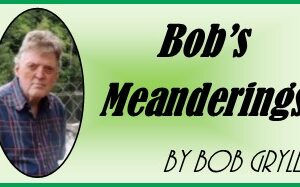Severe winds with almost tornado-like gusts were being forecasted. I checked the windows, secured the doors, picked up loose items from the lawn, finally lowering the flag. The next morning showed differently. Only a piddling breeze had been the result, not enough to roll a beer can haphazardly along the road.
A few times there have been warnings of imminent life-threatening hurricanes that scared the pants off everyone coupled with urgency to take cover – with or without pants. Cancelled before its arrival, I was disappointed. Surviving a hurricane is still on my bucket-list. So are other experiences such as flying in a Boeing 737 Max 8.
I guess it’s true – the weatherman usually can’t predict a full 24 hours in advance.
Maybe too harsh as some believe that 10% of the time, the forecast can be darn close.
When the weather map is displayed, it shows flowing colours reminding me of the colour spectrum that I learned about in high school art class. But the significance of the colours was Greek to me.
So, I did some research and found that a weather map and its symbols convey a lot of information quickly and without using a lot of words. Just as equations are the language of mathematics, weather symbols are the language of weather. Viewing a map, I could decipher the same information from it as a weatherman … that is, if I knew how to read it. I didn’t so I had more learning to do.
The map displaying the colours in warm weather from blue (clear skies at room temperature) encompassing other colours until it reaches red (extremely hot). The colours descend from blue to purple and black as it becomes colder.
The large letters (Blue H’s and red L’s) on weather maps indicate high- and low-pressure centers. Highs tend to bring clearing and stable weather, whereas lows encourage clouds and precipitation. These pressure centres are always marked on surface weather maps.
On some maps, there are lines surrounding and encircling the “highs” and “lows,” called isobars. Too complex for me, so I left it at that.
A weather connoisseur has reported that funny news stories about the weather are now almost as popular as funny stories about the former President.
During Brexit, PM Boris Johnson merged politics and weather. After he claimed that flooding currently hitting the north of England is a direct result of EU membership, voters began queuing up to support him.
“It’s simple,” explained Johnson. “After January, winds affecting water flows will be redirected. Rivers will be calmer, fish happier and no more flooded banks. Trade winds will blow to our benefit.”
Meteorologists were sceptical. “Winds and gusts tend to do what they want. And rivers are seldom subservient to politicians,” said BBC weather expert, Matt Taylor.
The worst winter storm I had to deal with was in January 1999 in Toronto. Without warning, it began around noon. I was at work in the west end of the city but lived in the east end. It took seven hours to get home – after many detours because of stranded cars.
The city was soon paralyzed by snowbanks reaching the second story of some houses. The snow-covered bus shelters were usable and outdoor sections of the subway came to a frigid halt. Mayor Lastman called in the army for help. More than 400 soldiers and 128 military vehicles arrived from CFB Petawawa as well as volunteers from Prince Edward Island.
The many people who despised Toronto and their Maple Leafs labelled the city ‘Winter Weather Wimps.’ It didn’t bother the iconic mayor, Mel Lastman. He claimed that he saved the day.
Getting back to the weather map, weather fronts appear as different colored lines that extend outward from the pressure center. Warm fronts are indicated by curved red lines with red semicircles. white Cold fronts are curved blue lines with blue triangles.
Wind speed is indicated by the shorter lines, called “barbs,” which extend from the longer line. Wind speed is measured in knots (1 knot = 1.15 miles per hour) and is always rounded to the nearest 5 knots.
Even weather apps are wrong with their forecasts. If you are an outdoor person, you don’t need them. A simple look to the sky should be your answer.





![Kenopic/Smith Auction [Paid Ad]](https://whitewaternews.ca/wp-content/uploads/2018/10/advertising-100x75.jpeg)

